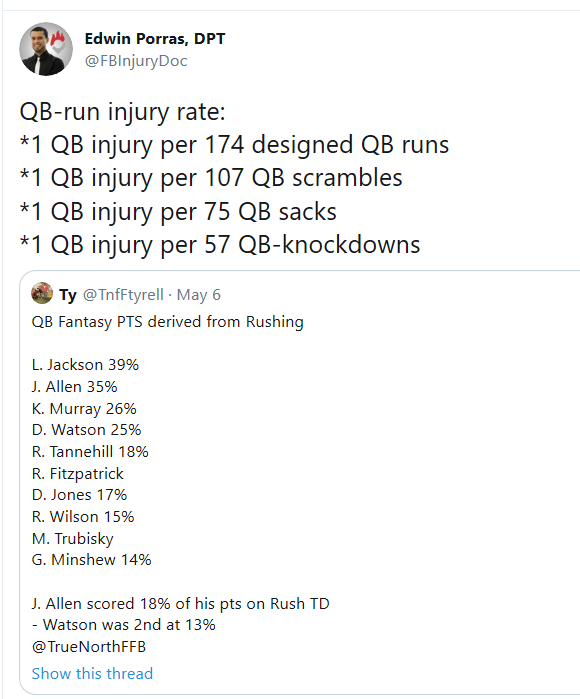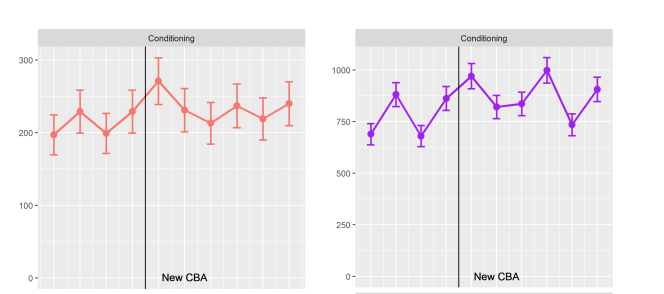There are plenty of narratives out there about NFL injuries and player health. So, what I want to do is provide some statistics with minimal opinion attached to help clarify some of the misconceptions about recurrence rates and other fantasy football related topics. Some of these are in order but this is primarily a semi-random assortment of statistics related to NFL injuries and fantasy football. Enjoy!
- Only 2.3% of NFL games are “injury-free.” When coupled with the rule of thumb that a history of missed time due to injury is the best predictor of future missed time due to injury, the term “injury-prone” really takes another L. Being healthy is the anomaly.
- From 2004-2014, no RB over the age of 28 saw more than 149 carries in a single season. Athleticism (agility, muscle mass, reaction time, neural connections) begins to ever-so-slightly decline beginning in a person’s late ’20s. Now, that’s not to say NFL players become frail from a real-life perspective at that age, but at the elite level where supreme athleticism reigns, well, supreme.
- David Johnson turns 29 in December.
- BMI is a medical tool created 150 years ago intended to measure the “average” person’s healthy weight. Nowadays, it helps predict a person's risk of chronic diseases such as diabetes and hypertension. Unfortunately, it doesn’t take into account muscle mass whatsoever (NFL players are mostly muscle) and is wildly inconsistent. So, since it’s bad at actually measuring its intended purpose, imagine how bad it is at measuring any type of athletic success. It should be a minimum threshold perhaps at best.
- In a study of 275 RBs, there was no difference in missed games (durability) between players with a Body Mass Index (BMI) of 29kg/m^2 and players with a BMI of 32kg/m^2.
- Hollywood Brown gained 10 lbs of muscle since the end of 2019.
- 21% of hamstring injuries in the NFL occur to WRs.
- In a study conducted on NFL athletes, 55% of players who had a dislocation of the shoulder joint ended up re-dislocating it again within three weeks of returning to action.
- Dalvin Cook, Tevin Coleman, and Jalen Reagor are three players who have had a shoulder subluxation/dislocation but no surgery.
- On a per season per and player basis, WRs account for 8% of all missed games due to injury compared to 7% for RBs.
- Since 2016, Julian Edelman, A.J. Green, and T.Y.Hilton have combined to miss 55 total games.
- From 2012-2014, WRs led the league in concussions at 30 concussions every 100 team games played.
- The true average return to play time for high ankle sprains is 15 days, not the commonly cited 4-6 weeks.
- Conversely, it does take 4-6 weeks for players to recover fully from the injury.
- RBs who carry the ball 300 times per season, on average, play in the NFL one season longer than RBs who see half as many carries.
- QBs are injured once every 341 dropbacks.
- Designed QB runs result in an injury once every 174 times.
- Scrambles result in a QB injury once every 107 times.
- Sacks result in a QB injury once every 75 times.
- QB knockdowns result in a QB injury once every 57 times.
- In 2019, non-kneel Lamar Jackson runs ended in no contact 46% of the time.
- RBs with lighter college workloads don’t play more NFL games than RBs with higher college workloads. Jonathan Taylor has entered the chat.
- The average age of a top 10 fantasy WR since 2017 is between 24-28.
- Adam Thielen turned 30 years old in August.
- Speaking of ages, {{Mark Ingram|RB|BAL} is 30 years and 9 months old.
- The average age of a top 24 RB in 2019 was between 24 and 26 years old.
- In the NFL, there is typically one rib injury per team per year.
- 72% of ACL tears are noncontact in the NFL.
- Rob Gronkowski has missed 26% of games due to injury.
- Among franchises with the same head coach since 2016, NE leads the NFL with a whopping 144 instances in which a skill player was listed on the final injury report as “Q”.
- Even more staggering, 73% of those skill players ended up playing that same week.
- For context, during that same time period, the Saints have listed 19 skill players as “Q” on the final injury report.
- Only 37% of those players have ended up being active on game day.
- There’s a 12% dip in production the first week that WRs come off of a hamstring strain.
- Jerick McKinnon has taken zero offensive snaps in the NFL since 2017.
- There’s a 21% reduction in offensive production for skill players in the first year after Lisfranc surgery.
- Sterling Shepard has had three documented concussions in his career and suffers from migraines.
- The most targets Josh Jacobs saw in 2019 was five in Week Nine.
- From Weeks Nine through 12, Jacobs’ target share went like this: 5-3-1-0.
- Before his injury in 2019, Alvin Kamara played 76% of snaps and created 37 yards per game against six teams with an average rushing DVOA ranked 14th.
- After his injury, those per game numbers fell to 66% of snaps and 15 yards created against teams with an average ranked rushing DVOA of 17 (i.e. he performed worse against worse defenses).
- Kamara has had one epidural injection.
- Todd Gurley finished the 2019 season with 14 touchdowns… nearly one touchdown per game. Only four other RBs scored more touchdowns than him.
- Gurley ranked 49th among qualified RBs in yards created in 2019.
- Will Fuller was off the injury report (yes, off) twice in 2019.
- Larry Fitzgerald has played 250 of 256 possible games. Wow.
- From Weeks Eight through 12 Saquon Barkley averaged 2.41 yards per attempt and 6.81 yards per target.
- From Weeks 13 through 17, Barkley averaged 5.74 yards per attempt and 8.65 yards per target.
- Matthew Stafford has suffered vertebral fractures twice in two years.
- Marquise Brown was on the injury report seven times with a “foot/ankle” problem in 2019.
- Hollywood Brown has had one screw removed from his foot/ankle.
- JuJu Smith-Schuster has had three documented concussions since 2017.
- The 3-year survival rate in the NFL after one concussion is 30%. In other words, 70% of NFL players who have a single concussion are out of the NFL after three seasons.
- On a positional basis per 100 games, TEs sustain 3.56 concussions per game.
- The second highest is WRs at 2.29 per 100 games.
- 2.5% of QBs tear their ACL in the NFL.
- Just 4.3% concussions in the NFL occur to QBs.
- Zach Ertz has had four hamstring injuries in the last five NFL seasons.
- Since 2015, the average age of a top 12 fantasy RB is tightly between the ages of 23 and 24 years and 10 months old.
- In 2011 the amount of "conditioning dependent" injuries spiked by 38%. This was the last time there wasn’t a true offseason and players didn’t have an adequate “ramp-up” period.
- Will Dissly has torn the two major tendons in the human body (Achilles/patellar).
- The average “power rating” drop after an Achilles tendon rupture is 78% for TEs.
- After patellar tendon ruptures, NFL players have the lowest return to play rate and the largest performance decreases.
- 0 injuries in NFL history have ever been objectively traced back to "overcompensation" of another body part.
- 82% of hamstring injuries are non-contact in nature.
- In 2019, Joe Dolan, Tom Brolley, and I will host one Fantasy Points podcast per week to discuss every fantasy-relevant before waivers run.
- 21% of hamstring injuries recur within a calendar year.
- 34% of players who suffer a hamstring injury have a history of a previous hamstring strain.
- Gronk retired with 80 touchdowns in 115 games. That’s 0.69 touchdowns per game. If you know what I mean.
Certainly, not all of these statistics have the context necessary to make an actionable decision, but hopefully they challenged your way of thinking about certain players.









